FTCE English 6-12 Test Competencies
Overview
The exam has five competencies in the multiple-choice section, and one competency that requires a written response:
- English Language (23%)
- Writing Skills (21%)
- Literacy Processes (21%)
- Fiction, Non-Fiction, and Informational Texts (23%)
- Response to Media (12%)
- Literary Analysis (Written Response)
So, let’s talk about English Language first.
English Language
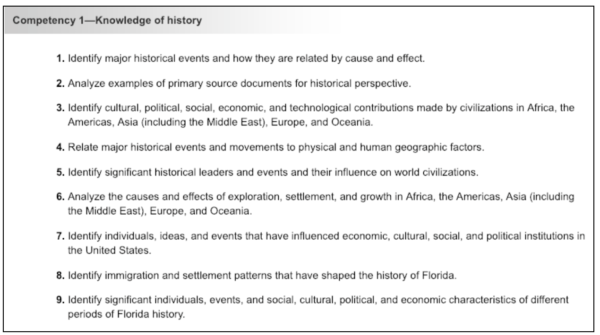
This competency includes about 18 multiple-choice questions, which make up about 23% of the entire exam.
This section tests your knowledge of the effective use of the English language.
Let’s talk about some concepts that you will more than likely see on the test.
Connotation and Denotation of Key Words
Connotation
is the feeling a word implies or creates. Denotation
is the dictionary definition of a word. See the examples below:
- Chick –We all know that a chick is a baby bird. But these days, it is considered to be a derogatory term for women. While it’s still a term associated with females, in no way does it uphold the characteristics of a respected lady.
- Rock –If you take it literally, then it could generally mean a stone composed of some type of minerals. But apart from that, a rock could also refer to an individual who offers you security and stability.
Structure and Meaning of Words
Prefixes and suffixes can be added to a base or root word to change the meaning. Prefixes are added to the beginning of a base word, and suffixes are added to the end.
Here is a word with a prefix and a suffix added to the root word:
non + conform + ist
not go along one who does something
A nonconformist
is someone who does not go along with others.
Figurative Language
Figurative language makes writing more interesting. Figurative language, such as idioms, metaphors, similes, hyperboles, and personification, help authors create impact and meaning in their writing by going beyond the literal meaning of words on a page.
Here are some examples of figurative language:
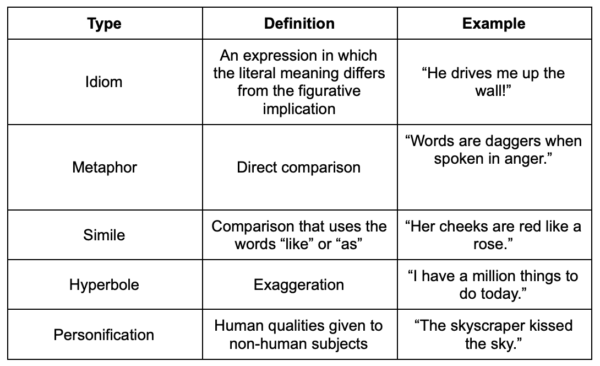
And that’s some basic info about English Language.
Writing Skills
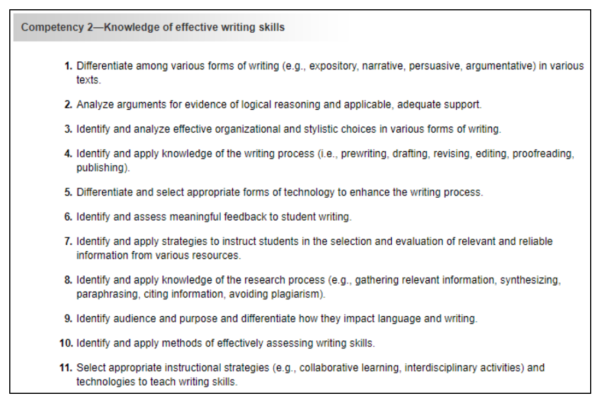
This competency includes about 17 multiple-choice questions, which make up about 21% of the entire exam.
This section tests your knowledge of effective writing skills.
Let’s talk about some concepts that you will plausibly see on the test.
Forms of Writing
Expository Writing
–
This type of writing presents reasons, explanations, or steps in a process. Typical characteristics include:
- Organization
- Topic sentence, thesis statement, and subtopics
- Transitions
- Evidence and examples
- Conclusion
Narrative Writing
–
This type of writing tells a story that includes a beginning, middle, and end. Typical characteristics include:
- Problem and solution
- Characters and setting
- Rising action and climax
- Plot
- Dialogue
Persuasive Writing
– This type of writing presents the development of a logical argument. Typical characteristics include:
- Clear, concise, and defined thesis
- Strong introduction
- The well-developed argument with strong support
- Organized structure
- Conclusion
Argumentative Writing
– This type of writing takes a position on an issue or topic. It explains and supports the position with research. Typical characteristics include:
- A clear, firm, and debatable thesis
- Background information on the topic
- Organization and transitions
- Effective and thorough research
- Incorporation of logos, pathos, and ethos
Writing Process
The writing process is
a series of steps followed in order to produce a coherent piece of writing.
Steps include:
- Prewriting– This is the first stage of the writing process. It consists of a combination of brainstorming and outlining.
- Drafting– This is where the author writes an initial draft.
- Revising– This is where the author reviews, alters and amends their initial draft.
- Editing– This is where the author reads each sentence carefully to make sure that his or her words are serving the correct purpose.
- Proofreading– This is where the author checks for and corrects spelling, grammatical, and punctuation errors.
- Publishing– This is the final step of the writing process. It is the presentation of the author’s final draft of writing.
Literary Processes
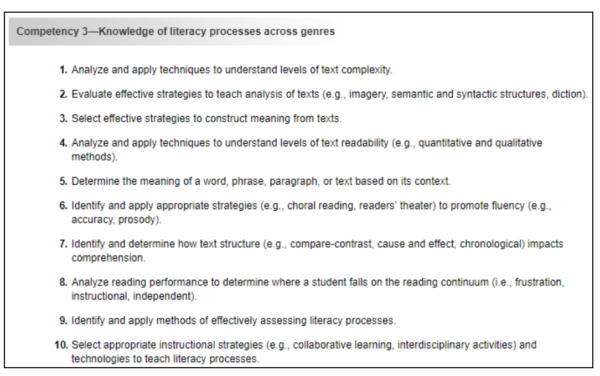
This competency includes about 17 multiple-choice questions, which make up about 21% of the entire exam
This section tests your knowledge of literacy processes across genres.
Let’s talk about some concepts that you will likely see on the test.
Text Complexity
Research shows that while the level of reading in college and careers has increased, the complexity of texts read in grades K-12 has decreased. This causes a gap for graduating high school students. It is important to have a measurable method for making sure students read on grade level.
To determine the complexity of the text, three factors are considered:
- Qualitative evaluation of the text: Levels of meaning, structure, language conventionality and clarity, and knowledge demands
- Quantitative evaluation of the text: Readability measures and other scores of text complexity
- Matching reader to text and task: Reader variables (such as motivation, knowledge, and experiences) and task variables (such as purpose and the complexity generated by the task assigned and the questions posed)
Text Analysis
Teaching the following strategies may help students to analyze a text:
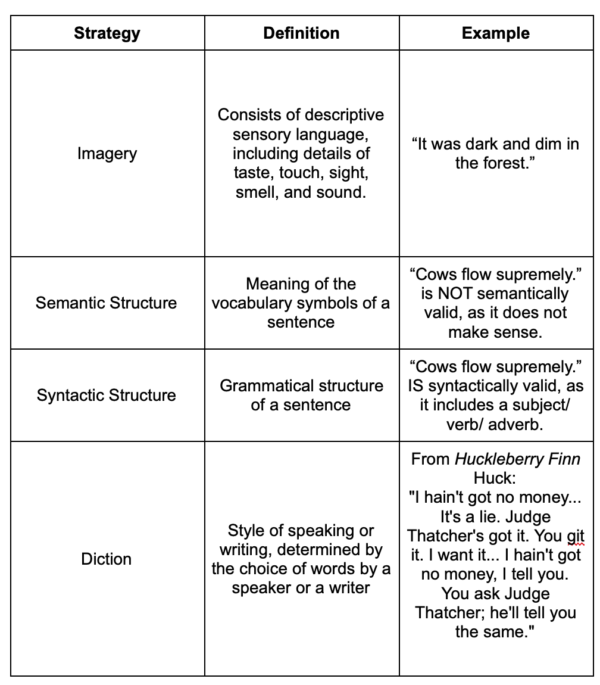
Text Structure
Text structures refer to how the information in a text is organized. Informational text is typically organized into one of six structures:
- Cause and Effect- an action or event causes another action or event
- Chronological- written in order of time/date
- Problem and Solution- a problem is presented, and then a solution is found
- Spatial- how a certain space is arranged
- Compare and Contrast- describes similarities and differences
- Descriptive- describes how something looks
Fiction, Non-Fiction, and Informational Texts
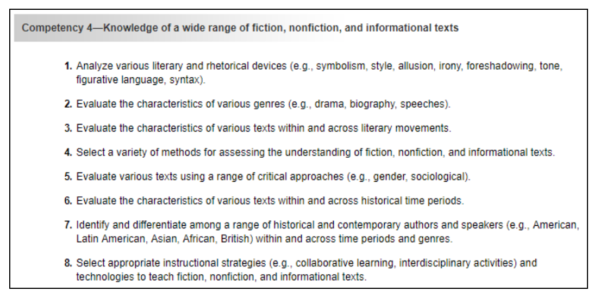
This competency includes about 18 multiple-choice questions, which make up about 23% of the entire exam.
This section tests your knowledge of fiction, non-fiction, and informational texts.
Let’s look at some concepts that are likely to pop up on the test.
Genres
The word genre means “artistic category or style.” A literary genre is a style of writing. Your favorite literary genre might be science fiction, for example. Three additional genres include:
- Drama– stories with characters that have dialog and action, typically written with the purpose of being acted out on a stage
- Biography– non-fiction text about a person’s life
- Speeches-oral communication typically presented to an audience about a topic of interest
Critical Approaches
A critical approach focuses on the reader (or audience) and his or her experience of a literary work, as opposed to the author or the content and form of the work.
Examples of Critical Approaches:
- Gender– examines the role and image of men and women in literature
- Sociological– examines the cultural, economic, and political context in literature
- Anthropological– examineshumanist and social science strategies in the literature
- Psychological– examines the effect that modern psychology has on literature
- Historical– examines a literary work by investigating the social, cultural, and intellectual context
Response to Media

This competency includes about 10 multiple-choice questions, which make up about
12% of the entire exam.
This section tests your knowledge of critical responses to media.
Here is a concept that is likely to be part of the test:
Analyzing Media
Students should be taught to analyze media, evaluating meaning, intent, effect, and technique.
Key questions to ask when analyzing media messages include:
- Evaluating meaning: What is this about? What has been left out? How might people interpret this message differently?
- Intent: Who made this message? Who paid for this message?
- Effect: Who might benefit or be harmed by this message? How might people respond?
- Technique: What techniques were used? Why were they used? How do they communicate the message?
Literary Analysis

This competency accounts for 100% of the written performance section of the exam.
This section tests your ability to demonstrate how to respond critically via literary analysis.
Let’s talk about how to write a literary analysis.
The writer must first develop a clear and coherent thesis statement. The thesis statement is found in the introductory paragraph and offers the main point in one sentence. Once this has been stated, a writer must proceed with ample evidence and relevant details to support the thesis. This includes using the research process, paraphrasing information from sources, and citing all sources that provide relevant information to the writer’s main argument. The writer must use postsecondary level English through varied word choice, semantics, and language conventions. The literary analysis should be written in a style that increases the reader’s interest and understanding of the topic.
And that’s some basic info about the FTCE English 6-12 exam.
